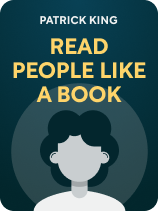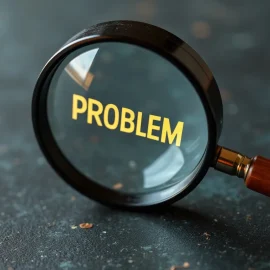

This article is an excerpt from the Shortform book guide to "Read People Like a Book" by Patrick King. Shortform has the world's best summaries and analyses of books you should be reading.
Like this article? Sign up for a free trial here.
Do you fall for people’s lies? How can tell when someone is lying?
Patrick King says that one of the main reasons people want to learn to read others is to detect when they’re being lied to. Nobody wants to be tricked, and a person who can detect lies has an advantage when negotiating or otherwise interacting with people.
Discover how to detect lies, no matter how big they are.
How to Detect a Liar
Unfortunately, it’s not easy to learn how to detect lies. Different people have different indicators because they react uniquely to the uncomfortable feeling of lying—one person might fidget while another frowns more than usual.
Furthermore, liars are often aware of how nonverbal cues can be read and will often consciously avoid making mistakes that would give them away. If they know averting their eyes conveys deceit, for example, they’ll make sure not to do that.
(Shortform note: Former FBI counterintelligence officer Joe Navarro agrees with King’s assertion that detecting lies is difficult, but offers another reason for it beyond the variability of nonverbal cues: We tend to believe those we like, and we look for signs of deception less critically when we want to believe what we’re hearing. Thus, even if someone doesn’t manage to hide their deceit indicators perfectly, we might overlook them due to our own subjectivity. This tendency has the potential to lessen the advantages of knowing what signs of deceit to look for.)
King writes that the best way to unearth a lie is not to look for individual, specific indicators, but instead, to have a conversation with the other person and then evaluate it holistically. Then:
- Try to make them mess up their story.
- Look for unnatural behaviors.
- Watch for emotions that don’t match the situation.
1. Make Them Mess Up Their Story
King writes that the best way you can get another person to reveal faults in their story is to stress their brain. Lying is mentally taxing, and if a liar is forced to devote more mental resources to their lie than they had planned, they’re more likely to slip up.
The best way to do this is to get them talking. The more they talk, the more opportunities they’ll have to say conflicting facts or to get details wrong. Start by asking open-ended questions to get the conversation flowing. Keep your tone casual so they don’t feel they’re being interrogated, which would cause them to clam up or get defensive. Your goal in the beginning of the conversation is to encourage them to reveal as much as possible.
King says that while getting them to talk, you should limit how much you contribute to the conversation. In particular, don’t reveal what you know about their lie. If they don’t know what you know, you’ll have an advantage, as they won’t be able to judge what information to hold back or adjust to fit the narrative.
As the conversation progresses, switch to specific questions about details of their story. Your goal here is to throw them off-balance. King writes that liars usually have rehearsed their tale but are unprepared to answer questions about things they haven’t thought through yet, which gives you an opening to poke holes in their story.
You can further tax their brains by repeating a part of their story slightly incorrectly, to see if they correct you—if you do this several times, they may not be able to keep track of their small details.
2. Look for Unnatural Behavior
When looking for deceit, King advises you not to fixate on specific, isolated actions like fidgeting or avoiding eye contact. Individual indicators might mislead you because a person who feels nervous (as they might if they sense you’re questioning them) may do things that show discomfort but don’t necessarily mean deceit.
Instead, watch for overall stiff or awkward behavior, especially at times when the conversation shifts tone or direction—and particularly around moments where the other person might need to make up details of a story. Do they start acting nervous at those points? Do they change from acting relaxed and friendly to suddenly being serious and blunt, or vice versa?
Notice, too, if they give you evasive answers to your questions, like if they ask a question back to you or remark on how strange your question is.
Further, watch for whether they seem to be making up details as they go—King writes that people who are telling the truth are more likely to say, “I don’t know,” if they’re missing some details of their story, but liars are more likely to make up details to fill in the missing spots.
| Look for Clusters of Behavior In What Every Body Is Saying, Joe Navarro echoes King’s principle, suggesting that it’s not isolated actions but clusters of behavior—such as stiffness, awkward movements, and rapid changes in mood—that can be telltale signs of deceit. He explains that when people lie, they’re grappling with nerves, guilt, or fear of being caught. This emotional struggle usually results in a bundle of nonverbal signals like sudden stiffness or irregular movements. Similarly, Navarro notes that evasive responses and the inability to say “I don’t know” often indicate a person is fabricating details because liars want their stories to seem convincing and complete, which makes them invent details even when unsure. Thus, he corroborates King’s view that the less likely someone is to say ”I don’t know,” the more likely they are to be lying. |
3. Watch for Inappropriate Emotional Responses
King writes that telling a lie is an inherently emotional experience (unless the liar is a psychopath). People are usually uncomfortable with it—although he warns that some may get a thrill out of it.
(Shortform note: King doesn’t define what makes a person a psychopath, but psychologists define it as a person who lacks empathy and other typical emotional responses. Such people will not react to lying emotionally, and thus, as King indicates, their deceit will be harder to identify. The other abnormal emotional reaction King mentions is getting a thrill out of lying. Psychologists refer to this as “duper’s delight,” and credit it to the rush of feeling smarter or craftier than others.)
In either case, liars typically have trouble staying true to fake facts while also behaving toward those facts with appropriate emotions:
- They might be overly matter-of-fact when telling a story that involves feelings like fear, surprise, or happiness. For example, a person might say she had spent the day visiting her elderly parents but not convey the angst and irritation she normally feels when visiting them.
- Or, they might be unreasonably angry—liars often put on a show of anger (“What are you trying to say?”) to deflect an inquiry.
(Shortform note: Charles Darwin explores the connection between lying and emotions in The Expression of Emotions in Man and Animals. He theorizes that lying triggers strong emotions because it goes against human nature. The discomfort you feel is a result of wrestling with the unnatural act of conveying false information—which becomes even more heightened if you fear getting caught. So, the emotional discomfort people naturally feel when lying may complicate any efforts to bolster their stories with convincing emotional expressions.)

———End of Preview———
Like what you just read? Read the rest of the world's best book summary and analysis of Patrick King's "Read People Like a Book" at Shortform.
Here's what you'll find in our full Read People Like a Book summary:
- How to look at someone and read their thoughts, desires, and personality
- How to spot liars, navigate relationships, and handle difficult people
- What someone's clothes can tell you about their mood and personality






